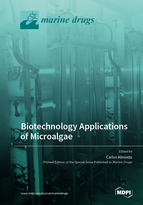Biotechnology Applications of Microalgae
A special issue of Marine Drugs (ISSN 1660-3397).
Deadline for manuscript submissions: closed (30 April 2022) | Viewed by 57879
Special Issue Editor
Special Issue Information
Dear Colleagues,
Microalgae are currently an inexhaustible source of a great variety of bioactive compounds. That is why they have acquired a great relevance in different biotechnological related industries as a source of products and services: food, feed and aquaculture, nutraceutical, pharmacological, biomedical, cosmetics, agriculture, energy or environmental processes. The plasticity of these organisms allows us to modify culture conditions in order to improve the performance, synthesis and accumulation, of the target compounds. However, the low profitability in the production of these compounds due to technical and economic issues associated to the development of cultivation and downstream processes have made some recent projects to fall by the wayside. In this sense, new technological advances are of the utmost importance for the industry to develop and be able to compete in quality and profitability with other current alternatives. In addition, they will allow opening new possibilities and paths for upcoming biotechnological applications.
This Special Issue on “Biotechnology Applications of Microalgae” seeks high quality research papers and reviews focused on the latest novel advances related to the production of the different bioactive compounds from microalgae and its biotechnological use.
Dr. Carlos Almeida
Guest Editor
Manuscript Submission Information
Manuscripts should be submitted online at www.mdpi.com by registering and logging in to this website. Once you are registered, click here to go to the submission form. Manuscripts can be submitted until the deadline. All submissions that pass pre-check are peer-reviewed. Accepted papers will be published continuously in the journal (as soon as accepted) and will be listed together on the special issue website. Research articles, review articles as well as short communications are invited. For planned papers, a title and short abstract (about 100 words) can be sent to the Editorial Office for announcement on this website.
Submitted manuscripts should not have been published previously, nor be under consideration for publication elsewhere (except conference proceedings papers). All manuscripts are thoroughly refereed through a single-blind peer-review process. A guide for authors and other relevant information for submission of manuscripts is available on the Instructions for Authors page. Marine Drugs is an international peer-reviewed open access monthly journal published by MDPI.
Please visit the Instructions for Authors page before submitting a manuscript. The Article Processing Charge (APC) for publication in this open access journal is 2900 CHF (Swiss Francs). Submitted papers should be well formatted and use good English. Authors may use MDPI's English editing service prior to publication or during author revisions.
Keywords
- Microalgae
- Biotechnological
- Bioactive compounds
- Biomedical
- Culture conditions
- Production







